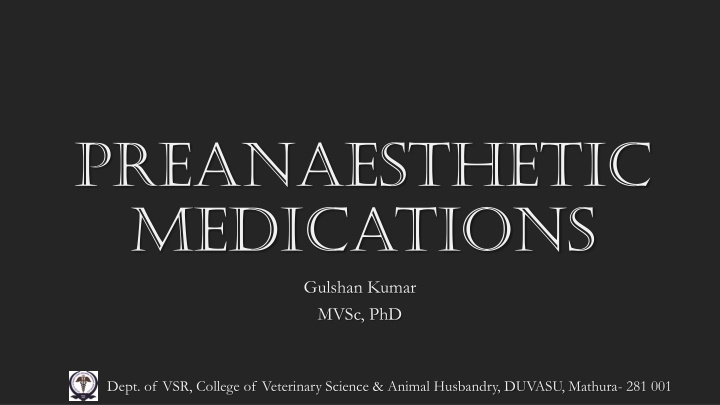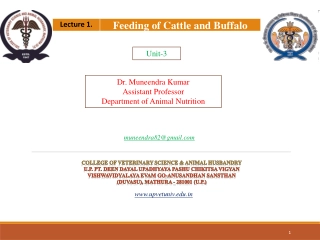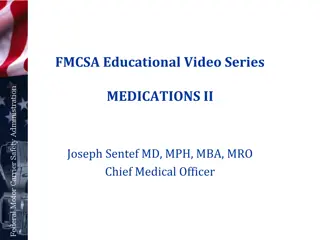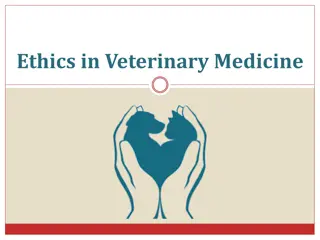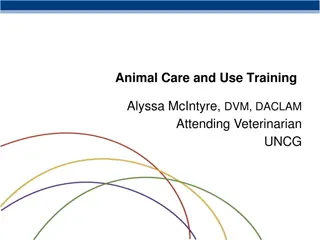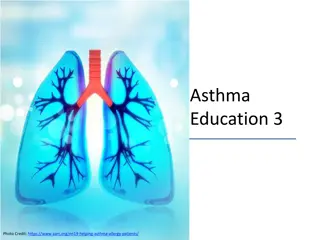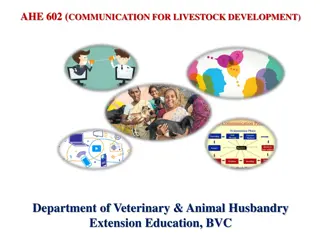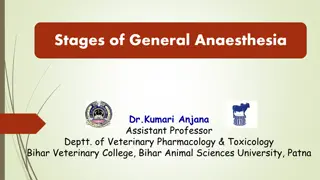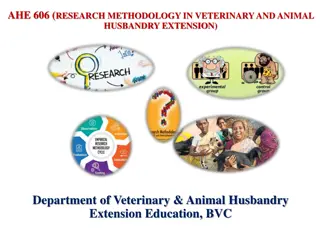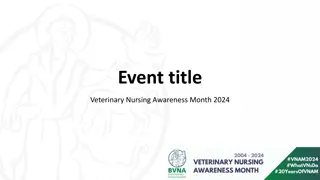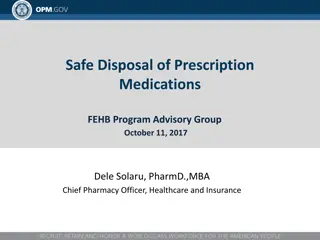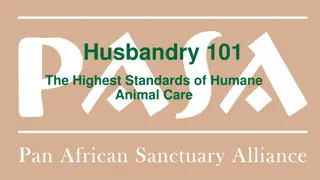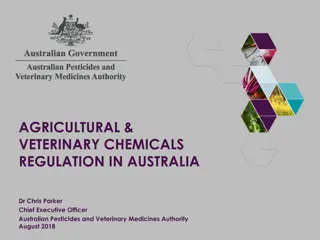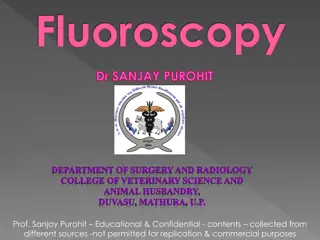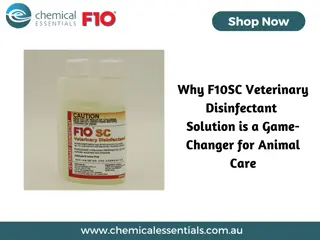Pre-Anaesthetic Medications in Veterinary Science & Animal Husbandry
The impacts of pre-anaesthetic medications in veterinary field, this article by Gulshan Kumar focuses on the use of these drugs in ensuring safe and effective anesthesia for animals. The author, holding a MVSc and PhD from VSR College of Veterinary Science & Animal Husbandry in Mathura, delves into the significance of pre-anaesthetic medication protocols, highlighting their crucial role in preparing animals for surgical procedures.
Download Presentation

Please find below an Image/Link to download the presentation.
The content on the website is provided AS IS for your information and personal use only. It may not be sold, licensed, or shared on other websites without obtaining consent from the author.If you encounter any issues during the download, it is possible that the publisher has removed the file from their server.
You are allowed to download the files provided on this website for personal or commercial use, subject to the condition that they are used lawfully. All files are the property of their respective owners.
The content on the website is provided AS IS for your information and personal use only. It may not be sold, licensed, or shared on other websites without obtaining consent from the author.
E N D
Presentation Transcript
PreAnaesthetic medications Gulshan Kumar MVSc, PhD Dept. of VSR, College of Veterinary Science & Animal Husbandry, DUVASU, Mathura- 281 001
Pre-anaesthetic medication (premedication): Pre-anaesthetic medication and selection of pre-anaesthetic agents are important components of safe anaesthetic protocol in tailoring anaesthetic regimen suitable for species, breeds, age and disease status. It is the term applied to the administration of drugs prior to general anaesthesia so as to make anaesthesia safer for the patient . They ensure comfort to the patient & to minimize adverse effects of anaesthesia Dept. of VSR, College of Veterinary Science & Animal Husbandry, DUVASU, Mathura- 281 001
Aims of pre-anaesthetic medication: To reduce fear and calm the patient, To reduce distress during restraining and minor manipulations like placement of catheters, To produce pre, intra and postoperative analgesia, To reduce salivary secretion and airway secretion, To decrease the total quantity or amount of the major anaesthetic drug (Synergism), To reduce the deleterious side effects of the major anaesthetic drug, To provide smooth induction, To reduce intra operative complications like vomiting and regurgitation and, To provide safe and smooth recovery. Dept. of VSR, College of Veterinary Science & Animal Husbandry, DUVASU, Mathura- 281 001
Classification: 1. Anticholinergics: Atropine sulphate, Glycopyrrolate 2. Tranquilisers or neuroleptics Phenothiazine derivatives: Chlorpromazine, Acepromazine, triflupromazine, promethazine Butyrophenones: Droperidol, Azaperone Benzodiazepines: Diazepam, Medazolam, Zolazepam alprazolam 3. Sedatives Alpha 2 adrenergic agonist: Xylazine, Detomidine, Medetomedine, Romifidine Chloral hydrate 4. Opioid agents Agonists: Morphine, Meperidine Partial Agonists/Antagonists: Pentazocine, Butorphanol. Dept. of VSR, College of Veterinary Science & Animal Husbandry, DUVASU, Mathura- 281 001
1. Anticholinergics: Compete with acetyl choline (Ach) attenuating the parasympathetic nerve impulses. E.g., Atropine sulphate, scopolamine (hyoscine), Glycopyrrolate. Atropine sulphate is a natural product (alkaloid) obtained from Atropa belladonna. Scopolamine (Hyoscine) is not used in veterinary practice. Glycopyrrolate is a synthetic quaternary ammonium compound These are used to: Suppress the vagal tone, Reduce salivary and bronchial secretions Premedication with anticholinergics is contraindicated in ruminants (salivary and bronchial secretions become more viscid and hence block the airways. Dept. of VSR, College of Veterinary Science & Animal Husbandry, DUVASU, Mathura- 281 001
1. Anticholinergics: Their routine use has decreased, but their use is still recommended in animals with preexisting bradycardia or in combination with drugs which cause bradycardia (e.g., Xylazine). they are known to increase the heart rate by blocking the vagal effect on the sinu-atrial node. This increase is associated with increased myocardial oxygen consumption, hence contraindicated in those with preexisting tachycardia, heart failure or cardiac myopathies. Large doses of atropine cause the cutaneous vessels to dilate (Atropine flush). Decrease salivary, bronchial and gastric secretions, and GI motility and dilate bronchi and increase pulmonary dead space. Dept. of VSR, College of Veterinary Science & Animal Husbandry, DUVASU, Mathura- 281 001
1. Anticholinergics: Induce mydriasis due to cholinergic blockade of iris and ciliary body and paralyse accommodation reflex (cycloplegia) leading to photophobia and blurred vision. Relax the urinary tract smooth muscles and tend to cause urinary retention. Excessive dose of atropine and scopolamine may induce hallucination, excitement and seizures. Not noticed in case of glycopyrrolate, as it does not cross the blood-brain barrier. Due to this property glycopyrrolate is considered as a useful premedicant in equine anaesthesia. Indicated in eye surgeries whether performed under local or general anaesthesia to prevent oculo-cardiac reflex. The undesirable effects of atropine and glycopyrrolate can be reversed with Neostigmine or Physostigmine. Dept. of VSR, College of Veterinary Science & Animal Husbandry, DUVASU, Mathura- 281 001
1. Anticholinergics: Drug Advantages Disadvantages 1. If myocardial oxygen demand is not met, may cause cardiac arrhythmias Atropine Sulphate 1. Less expensive 2. Tachycardia is not extreme as in glycopyrrolate. 3. Quick action hence indicated when immediate treatment of bradycardia is required. 1. Less dose is required. 2. Bradycardia is controlled effectively. 3. Controls gastric acid pH; avoids acid aspiration. 4. Less intestinal stasis, hence indicated in horses to reduce the incidences of post-anaesthetic ileus causing colic. Glycopyrrolate Sialorrhoea is not controlled as effectively. Dept. of VSR, College of Veterinary Science & Animal Husbandry, DUVASU, Mathura- 281 001
1. Anticholinergics: 2. Dosage: Species Atropine Sulphate 0.02-0.05 mg/kg s.c./i.m. 0.20 mg/kg i.m. 0.3-1.8 mg total 0.02-0.05 mg/kg s.c./i.m. 0.1-0.2 mg /kg i.v. 0.2-0.1 mg/kg s.c./i.m. 0.01-0.02 mg/kg i.v. Glycopyrrolate 0.02 mg/kg s.c./i.m. 0.01 mg/kg i.m. Horse Goat Pig Dog 0.01-0.02 mg/kg s.c./i.m./i.v. Cats 0.01-0.02/kg s.c./i.m./i.v. Dept. of VSR, College of Veterinary Science & Animal Husbandry, DUVASU, Mathura- 281 001
2. Tranquillisers or neuroleptics: (a) Phenothiazine derivatives: They Are basically three ring structures in with two benzene rings linked by a sulphur and nitrogen atom. Act on the central nervous system by depressing the brain stem and connections of the cerebral cortex. Increase the dopamine and norepinephrine turn over in the brain and block the peripheral actions of catecholamines at alpha 1 receptors. Are weak anticholinergics and have extrapyramidal stimulating properties. Examples-Acepromazine maleate, chlorpromazine, promazine, promethazine and methotrimeprazine Among these, acepromazine, triflupromazine and chlorpromazine are used in veterinary anaesthesia. triflupromazine hydrochloride, Dept. of VSR, College of Veterinary Science & Animal Husbandry, DUVASU, Mathura- 281 001
2. Tranquillisers or neuroleptics: (a) Phenothiazine derivatives: They Produce general calming, sedation and reduction in motor activity. Antagonize dopamine excitatory chemoreceptors and suppress vomiting. Induce extrapyramidal signs such as rigidity, tremors and catalepsy at high doses and sometimes in clinical doses. Hence contraindicated in patients With the previous history of epilepsy, Undergoing myelographic procedures With the history of recent intake of organophosphorus drugs or toxicity. Induce urine production due to the suppression of antidiuretic hormone. Provide good muscle relaxation. Dept. of VSR, College of Veterinary Science & Animal Husbandry, DUVASU, Mathura- 281 001
2. Tranquillisers or neuroleptics: (a) Phenothiazine derivatives: Species Acepromazine Horse 0.02-0.04 mg/kg i.v. 0.04-0.09 mg/kg i.m. Cattle 0.02-0.05 mg/kg i.v. 0.04-0.09 mg/kg i.m. Goat - Sheep - Pig 0.1mg/kg i.m. Chlorpromazine 1.1-2.2 mg/kg i.m. Promazine Triflupromazine 0.44-1.1 mg/kg i.v., i.m. 0.2-1.1 mg/kg i.v. 0.2-2.2 mg/kg i.m. 0.55-4.4 mg/kg i.v. - 1.0-2.0 mg/kg i.m. 0.44-1.1 mg/kg i.v., i.m. 0.44-1.1 mg/kg i.v., i.m. 0.44-1.1 mg/kg i.v., i.m. 0.44-1.1 mg/kg i.v., 0.44- 4.0 mg/kg i.m. - Dog 0.03-0.05 mg/kg i.v./i.m. 0.55-4.4 mg/kg i.v. 1.1-6.6 mg/kg i.m. 0.55-4.4 mg/kg i.v. 1.1-6.6 mg/kg i.m. 1.0 mg/kg Cats 0.03-0.05 mg/kg i.v., 0.03-0.1 mg/kg i.m. - Dept. of VSR, College of Veterinary Science & Animal Husbandry, DUVASU, Mathura- 281 001
2. Tranquillisers or neuroleptics: (b) Butyrophenone derivatives: Butyrophenones have similar properties like phenothiazines. They Block the central actions of dopamine and norepinephrine. Are more likely to produce extrapyramidal signs like tremors, rigidity and catalepsy in clinical doses hence not popular. Examples- Droperidol, Fluanisone, Azaperone and Lenperone Are potent antiemetics and even prevent drug induced vomiting produced by opioid analgesics by acting on the chemoemetic trigger zone. Hence used as neuroleptic analgesics in anaesthetic regimen. Have less cardiac depressive effects and the hypotension produced by the agents can easily be reversed with phenylephrine. Induce minimal changes in respiratory parameters. Muscle relaxation is similar to that of phenothiazine derivatives Dept. of VSR, College of Veterinary Science & Animal Husbandry, DUVASU, Mathura- 281 001
2. Tranquillisers or neuroleptics: (b) Butyrophenone derivatives: i. Droperidol- o Used in combination with an opioid analgesic, fentanyl citrate (fentanyl citrate 0.4 mg + droperidol 20 mg per ml as Innovar vet) which produces profound analgesia for 30 minutes and sedation for a considerable time in dogs. o May induce undesirable central nervous system stimulation in cats. o Causes panting, aggression upto 48 hours after recovery, defaecation and salivation. o Clinical dose Dogs 0.05 0.1 mg/kg I.M Cats 0.10 0.11 mg/kg S.C Pigs 0.10 0.4 mg/kg I.M Dept. of VSR, College of Veterinary Science & Animal Husbandry, DUVASU, Mathura- 281 001
2. Tranquillisers or neuroleptics: (b) Butyrophenone derivatives: ii. Azaperone- o Clinical use is usually restricted to healthy pigs in which it is administered prior to metomidate. Azaperone sometimes produce muscle tremors, sweating and excitement in horses hence it is unsuitable for equine anaesthesia. o Clinical dose- Pigs 0.4 1.2 mg/kg i.m. (low dose), 2.0 mg/kg i.m. (medium dose), 4.0 mg/kg i.m. (high dose) o Doses greater than 1.0 mg/kg i.m. may cause paraphimosis in boars probably due to vasodilatory effects which may predispose for injury. Dept. of VSR, College of Veterinary Science & Animal Husbandry, DUVASU, Mathura- 281 001
2. Tranquillisers or neuroleptics: (b) Butyrophenone derivatives: iii. Fluanisone- o It is available in combination with fentanyl citrate as Hyponorm (fluanisone 10 mg+fentanyl l0.315 mg). o This combination is contraindicated in patients with respiratory, renal and hepatic diseases. Naloxone is the reversal agent for this combination. o Clinical dose Dogs: 5 mg/kg along with 0.1 mg/kg of fentanyl citrate (neuroleptanalgesia). Dept. of VSR, College of Veterinary Science & Animal Husbandry, DUVASU, Mathura- 281 001
2. Tranquillisers or neuroleptics: (c) Benzodiazepine derivatives: Benzodiazepines exerts their effects by binding to a specific binding site on gamma aminobutyric acid (GABA) receptors. Have no analgesic property. Good anxiolytics, hypnotics and anticonvulsants. Have minimal respiratory and cardiovascular depression. Produce muscle relaxation. Examples- Diazepam, midazolam, climazolam and zolazepam. These agents are combined with opioid analgesics and dissociative anaesthetics. Dept. of VSR, College of Veterinary Science & Animal Husbandry, DUVASU, Mathura- 281 001
2. Tranquillisers or neuroleptics: (c) Benzodiazepine derivatives: i. Diazepam: Used to treat status epilepticus in dogs, cats and human. Can not be used as a sole sedative agent in dogs and cats. In horses it produces excitation if used as a sole sedative pre-anaesthetic agent hence combined with xylazine. Decreases the release of catecholamines and act as antidysrrhythmic agent. Used as an effective appetite stimulant in dogs and cats at the dose of 0.05 0.40 mg/kg Oral/I.M. Dept. of VSR, College of Veterinary Science & Animal Husbandry, DUVASU, Mathura- 281 001
2. Tranquillisers or neuroleptics: (c) Benzodiazepine derivatives: i. Diazepam: In human it causes congenital anomalies if administered during the first trimester of pregnancy. And the significance of this is not clear in veterinary practice. It is absorbed by plastic materials hence storage in plastic syringes, infusion bags and infusion tubes are not advisable. Rapid intravenous injection may cause thrombosis. Dept. of VSR, College of Veterinary Science & Animal Husbandry, DUVASU, Mathura- 281 001
2. Tranquillisers or neuroleptics: (c) Benzodiazepine derivatives: i. Diazepam: Dose Dogs 0.1 0.5 mg/kg i.v., 0.3 0.5 mg/kg i.m. Cats 0.05 0.4 mg/kg i.v., 0.3 1.0 mg/kg i.m. Horses 0.02 0.04 mg/kg i.v. Foals 0.1 0.2 mg/kg i.v. Cattle 0.1 mg/kg i.v. Goat 0.1 0.1 mg/kg i.v.. Pigs 1.0 mg/kg i.v. Dept. of VSR, College of Veterinary Science & Animal Husbandry, DUVASU, Mathura- 281 001
2. Tranquillisers or neuroleptics: (c) Benzodiazepine derivatives: ii. Midazolam: Twice as potent as diazepam. Can be administered as premedicant to thiopentone, ketamine and propofol anaesthesia. Metabolized in the liver rapidly hence less cumulative can be stored in aqueous solution in plastic container for up to 100 hours without loss of potency. Dose: Dogs & cats- 0.07 0.22 mg/kg i.m/i.m. Dept. of VSR, College of Veterinary Science & Animal Husbandry, DUVASU, Mathura- 281 001
2. Tranquillisers or neuroleptics: (c) Benzodiazepine derivatives: iii. Climazepam: A potent benzodiazepine, used in cattle, sheep, horses and dogs. In horses the drug is combined with other pre-anaesthetic agents and anaesthetics as it may produce excitement and muscle weakness. Dose: Dogs-1.0 1.5 mg/kg in combination with 5.15 mg/kg of fentanyl i.v. Horses 0.05 0.2 mg/kg i.v. Cattle 0.5 1.1 mg/kg i.m. Sheep & goats 0.5 1.1 mg/kg i.m. Pigs 0.5 1.0 mg/kg i.m. Chicken 5.5 11.0 mg/kg i.m. Dept. of VSR, College of Veterinary Science & Animal Husbandry, DUVASU, Mathura- 281 001
2. Tranquillisers or neuroleptics: (c) Benzodiazepine derivatives: The action of benzodiazepines can be antagonised/reversed by flumazenil @ 0.1 mg/kg i.m. Dept. of VSR, College of Veterinary Science & Animal Husbandry, DUVASU, Mathura- 281 001
3. 2 (alpha 2) Adrenergic agonists: 2 adrenergic agonists are referred as sedative analgesics. They are popular because they produce profound, reliable sedation as well as analgesia. The first 2-adrenergic agonist drug used in veterinary medicine was xylazine. It was developed as a human antihypertensive drug but clinical evaluation identified sedation as a potent side effect. agents are xylazine hydrochloride, detomidine, medetomidine and romifidine Dept. of VSR, College of Veterinary Science & Animal Husbandry, DUVASU, Mathura- 281 001
3. 2 (alpha 2) Adrenergic agonists: (a) Xylazine Hydrochloride: It is a sedative analgesic having alpha 2 adrenergic agonist activity. Produces dose-related depression of the central nervous system. The analgesic activity is lasts for 15-30 min. and the sedation is for 1-2 hours. Ruminants are more sensitive to xylazine. One tenth of the dose used in horses and dogs induce sedation and recumbency in cattle. In horses it is a reliable sedative and the horse will remain standing in clinical doses. Commonly the head droops and hind limbs buckle in horses. The clinical dose through intravenous route is 1.1 mg/kg. Further increase in the dose will not increase the intensity of sedation, only the duration will be increased. . Dept. of VSR, College of Veterinary Science & Animal Husbandry, DUVASU, Mathura- 281 001
3. 2 (alpha 2) Adrenergic agonists: (a) Xylazine Hydrochloride: Causes emesis in dogs and cats due to the stimulation of central emetic center. Produces muscle relaxation, attributed to decrease in intraneural and synaptic transmission in the central nervous system. It is used in the treatment of equine colic for pain relief. But it must be used with caution as it may mask the clinical signs and may aggravate ileus. It induces profound depression of cardiovascular system (bradycardia, decreased cardiac output, hypotension and increase in central venous ). Often produces A.V block. i.v. administration causes a transient increase in blood pressure. Dept. of VSR, College of Veterinary Science & Animal Husbandry, DUVASU, Mathura- 281 001
3. 2 (alpha 2) Adrenergic agonists: (a) Xylazine Hydrochloride: Xylazine administration decreases the injectable and inhalational anaesthetic requirements dramatically. Administration of anticholinergics as pre-anaesthetic agents reduce the incidence of bradycardia and even the bradycardia that occurs after administration of xylazine can be reversed with atropine (0.045 mg/kg initially and followed by 0.01 mg/kg intravenously). It is contraindicated in brachycephalic breeds, older dogs and in intestinal obstruction. .. Dept. of VSR, College of Veterinary Science & Animal Husbandry, DUVASU, Mathura- 281 001
3. 2 (alpha 2) Adrenergic agonists: (a) Xylazine Hydrochloride: Increases the sensitivity of myocardium to the circulating catecholamines. Cardiac dysrhythmias may occur if used along with halothane. Reduces the g.i. and ruminal motility with relaxation of cardia /oesophageal sphincter, favouring ruminal tympany and regurgitation in ruminants. Has oxytocic property and increase the intrauterine pressure hence, may induce abortion in pregnant animals. .. Dept. of VSR, College of Veterinary Science & Animal Husbandry, DUVASU, Mathura- 281 001
3. 2 (alpha 2) Adrenergic agonists: (a) Xylazine Hydrochloride: Depresses thermoregulation; the animal may become hypothermic or hyperthermic depending on the ambient temperature. Also used as epidural anaesthetic because of the presence of alpha receptors in the spinal cord and its structural similarity with lidocaine. Other effects diuresis, because of the suppression of antidiuretic hormone, salivation, Hyperglycemia, .. Dept. of VSR, College of Veterinary Science & Animal Husbandry, DUVASU, Mathura- 281 001
3. 2 (alpha 2) Adrenergic agonists: (a) Xylazine Hydrochloride: Dose o Horse 1.1 mg/kg i.v./i.m. o Dogs & cats 0.2 -1.1 mg/kg i.v./i.m./.s.c. o Cattle, sheep & goats 0.05 0.08 mg/kg i.m. standing restraint 0.1 0.3 mg/kg i.m. recumbency and prolonged 0.1 0.2 mg/kg i.v. recumbency o Pigs 1.0 2.0 mg/kg i.v. Up to 4.0 mg/kg i.m. Epidural 0.07 0.17 mg/kg in 5.0 to 10.0 ml of saline, Dept. of VSR, College of Veterinary Science & Animal Husbandry, DUVASU, Mathura- 281 001
3. 2 (alpha 2) Adrenergic agonists: (b) Detomidine: Potent alpha 2-adrenaergic agonist, mainly used in horses and cattle. Advantages: o Does not stimulate pituitary adrenocortical axis hence stress is less. o Can be administered in pregnant animals o Can be administered in animals which are not fasted o It is very effective in relieving pain from colic in horses. o Provides standing restraint in cattle at the dose of 10 to 20 g/kg I.V Dose: Horse, Cattle, Sheep & Goats 10 - 40 g/kg I.V * Not recommended in dogs, cats and wild felines Dept. of VSR, College of Veterinary Science & Animal Husbandry, DUVASU, Mathura- 281 001
3. 2 (alpha 2) Adrenergic agonists: (c) Medetomidine: Potent alpha 2-adrenaergic agonist, used in small animals. Other properties similar to those of xylazine. Dose: Dogs- 0.01-0.04 mg/kg i.v./i.m./s.c. Cats- 0.04-0.08 mg/kg i.v./i.m./s.c. Cattle- 0.01-0.02 mg/kg i.v. (d) Romifidine: Developed from clonidine and has alpha 2 adrenergic agonistic action. Used in horses and maximum sedation is achieved at the dose of 80 g/kg i.v. Dept. of VSR, College of Veterinary Science & Animal Husbandry, DUVASU, Mathura- 281 001
3. 2 (alpha 2) Adrenergic agonists: Reversal agents for 2 adrenergic agonists Yohimbine HCl: Specific reversal agent for Xylazine and Detomidine. Used @ 0.1 mg/kg i.v. Often combined with 4-aminopyridine (0.04 mg/kg) for better results. Reverses g.i. stasis caused by xylazine, used in horses for treatment of colic due to ileus. Atipamizole: Reverses the action of medetomidine. Used @ 0.04-0.5 mg/kg i.v. Doxapram: Not specically reversal agent but is beneficial due to its CNS stimulation and respiratory stimulation. Dept. of VSR, College of Veterinary Science & Animal Husbandry, DUVASU, Mathura- 281 001
3. Chloral Hydrate: Has been used as a reliable sedative hypnotic for cattle and horse. Cheap and still acceptable, has aromatic odour and bitter taste. CNS depressant effect is due to the action of its metabolite-2, 2, 2 trichloro ethanol, so the sedative effect lasts even after cessation of its administration. Has no analgesic effect. Depresses the motor and sensory responses at sedative dose and produces cerebral and medullary center depression at anaesthetic dose resulting in muscle relaxation and depression of cardiac and respiratory system. Cattle-30-120 g as 1 in 20 soln in water, drenched through stomach tube. OR 80-90 gram as 10% solution, i.v. Also combined with magnesium sulphate 2:1 or 3:1 . Dept. of VSR, College of Veterinary Science & Animal Husbandry, DUVASU, Mathura- 281 001
3. Chloral Hydrate: Horses: combined with magnesium sulphate and pentobarbital (Equithesin) Intravenous dose in horses: o Chloral hydrate alone 5 to 10 mg/kg for mild sedation and hypnosis, 20 to 40 mg/kg for moderate sedation and hypnosis, 50 to 75 mg/kg for profound sedation and hypnosis and 150 to 250 mg/kg for anaesthesia. o Chloral hydrate 100 mg/kg and thiopentone 1.5 to 2 mg/kg o Chloral hydrate 100 mg/kg and ketamine 1.5 to 2 mg/kg o Promazine 0.6 to 0.8 mg/kg, 7% chloral hydrate 20 to 40 mg/kg and thiopentone 5 to 7 mg/kg o Acepromazine 0.04 to 0.08 mg/kg, 7% chloral hydrate 20 to 40 mg/kg and thiamylal 2 to 4 mg/kg. o Xylazine 0.4 to 0.6 mg/kg, 7% chloral hydrate 20 to 40 mg/kg and thiamylal 1 to 2 mg/kg. . Dept. of VSR, College of Veterinary Science & Animal Husbandry, DUVASU, Mathura- 281 001
3. Chloral Hydrate: Disadvantages: o Prolonged hangover with ataxia and stupor o Perivascular administration causes pain, swelling and necrosis o Induces abortion in mares Dept. of VSR, College of Veterinary Science & Animal Husbandry, DUVASU, Mathura- 281 001
4. Opioid agents: (a) Pure agonists: (i) Morphine: o Derived from the dried milky exudate of the unripe seed capsules of the opium poppy (Papaver somniferum). o The exudates contains 3-25% of morphine, 5% noscapine and 0.8% papaverine. o The laboratory synthesis of morphine is different hence still it is derived from opium poppy. o The laboratory synthetic agents are codeine, heroin (dimorphone or diacetylmorphone) and oxymorphone. . Dept. of VSR, College of Veterinary Science & Animal Husbandry, DUVASU, Mathura- 281 001
4. Opioid agents: (a) Pure agonists: (i) Morphine: Effects- o Analgesia, drowsiness, produces nausea and vomiting by stimulating chemoreceptor trigger zone. o Induces dopaminergic excitement in cats, horses pigs, dogs and cattle. o Depresses respiration, depresses cough. o Myocardial effects are insignificant but increases vagal tone causing slowing of heart. o Absorbed from oral mucosa and gut. Reduces stomach motility. o Potent analgesic for post operative pain. o Preservative free morphine can be used epidurally to relieve pain. Dept. of VSR, College of Veterinary Science & Animal Husbandry, DUVASU, Mathura- 281 001
4. Opioid agents: (a) Pure agonists: (i) Morphine: Dose: o Horses: gives good results in horses if administered after xylazine sedation. Xylazine 1.0 mg/kg i.v. and morphine 0.6 mg/kg i.v. o Dogs 0.2 0.5 mg/kg (total dose not exceeding 10 mg ) i.m./i.v. o Cats 0.05 0.1 mg/kg s.c./i.m. must be administered with caution because it may induce CNS stimulation. Hence must be used with suitable tranquilizer. o Morphine is administered after administration of Acepromazine. Acepromazine 0.1 mg/kg i.m. and Morphine 0.6 mg/kg i.m. Dept. of VSR, College of Veterinary Science & Animal Husbandry, DUVASU, Mathura- 281 001
4. Opioid agents: (a) Pure agonists: (ii) Pethidine: o It is a vago-lytic and negative inotropic drug at clinical doses. o It reduces salivation and respiratory secretion without inducing vomiting and defecation. o It induces histamine release if administered through intravenous route. o Dose: Dogs- 2-6.5 mg/kg s.c./i.m., cats- 2- 4.4 mg/kg s.c./i.m. (iii) Meperidine: o It is synthetic, less potent (1/10th of morphine). o Intravenous administration causes histamine release hence commonly given with acepromazine (phenothiazines are potent antihistaminics). o Dose: Dogs & cats- 2-5 mg/kg i.m. Dept. of VSR, College of Veterinary Science & Animal Husbandry, DUVASU, Mathura- 281 001
4. Opioid agents: (a) Pure agonists: (iv) Oxymorphone: o Synthetic derivative having 10 times greater potency than morphine. o Widely used in dogs and cats for analgesia which lasts for 4 hours. o It does not cause histamine release as meperidine. o Used popularly in small animal anaesthesia for the above two properties. o It stimulates the vagus leading to brady-arrhythmias which can be reduced/prevented with the use of anticholinergic agents in the protocol. o It is also administered epidurally to control pain in the hindquarters (0.025 - 0.05 mg/kg). Dose: Dogs- 0.05-0.2 mg/kg i.v./s.c./i.m. total not to exceed 4.5 mg), cats- 0.05-0.4 mg/kg s.c./i.m./i.m., horses- 0.02-0.03 mg/kg i.v/i.m. Dept. of VSR, College of Veterinary Science & Animal Husbandry, DUVASU, Mathura- 281 001
4. Opioid agents: (a) Pure agonists: (v) Fentanyl citrate: It is a synthetic opioid product related to phenylpiperidines. Its analgesic property is 80 times greater than morphine. Cardiac output, heart rate, respiratory rate and arterial oxygen tension (PaO2) are reduced following administration of fentanyl. Fentanyl citrate is available alone, or in combination with droperidol (Innovar vet contains 0.4 mg of fentanyl and 20 mg of droperidol per milliliter) or fluanisone. (Hypnormcontains 0.315 mg of fentanyl and 10 mg of fluanisone per milliliter) Fentanyl combinations provide good intra operative analgesia. In dogs and primates it produces sedation and myosis whereas in horses it produces excitement and mydriasis. It is not recommended in cats. Dose - Dogs 0.01 - 0.02 mg/kg I.M/I.V. (see butyrophenones for other doses). The other synthetic pure agonists are afentanil, sufentanil, lofentanil and carfentanil. Dept. of VSR, College of Veterinary Science & Animal Husbandry, DUVASU, Mathura- 281 001
4. Opioid agents: (a) Pure agonists: (vi) Etorphine: Potent synthetic morphine derivative. Its general properties are similar to morphine. The dose of etorphine is 0.5 mg/500 g B.W Etorphine is an extremely long acting agent whose effects are maintained by enterohepatic recycling. Can only be antagonised by the use of the specific antagonist Diprenorphine. Clinical dose of etorphine alone may produce initial excitement hence it is marketed in combination with phenothiazine derivatives. Separate combinations are available for large and small animals. Each pack of the marketed drug will be having two components. 1-Immobilon and 2-Revivon. Dept. of VSR, College of Veterinary Science & Animal Husbandry, DUVASU, Mathura- 281 001
4. Opioid agents: (a) Pure agonists: (vi) Etorphine: Preparations- Immobilon L A contains Etorphine 2.45 mg/ml and acepromazine 10 mg/ml Immobilon S A contains Etorphine 0.074 mg/ml and Methotrimeprazine 18 mg/ml Revivon L A contains Diprenorphine 3.0 mg/ml Revivon S A contains Diprenorphine 0.272 mg/ml This mixture is popularly used to capture elephants and giraffes Not recommended for domesticated and wild felines Etorphine is extremely potent in human and any accidental injection may cause death if not treated with naloxone or diprenorphine. Dept. of VSR, College of Veterinary Science & Animal Husbandry, DUVASU, Mathura- 281 001
4. Opioid agents: (a) Pure agonists: (vii) Pentazocine: Used as an analgesic. It produces pulmonary vascular resistance in clinical doses. Used in the treatment of colic and administered at the rate of 0.33 mg/kg i.v. in horses. Dose -3 mg/kg for 1 to 3 hours of analgesia. Penlog -Duration of analgesia 3-4 hour. Onset 1 min one hour (viii) Butorphanol tartrate: Used in horses, cats and dogs. Produces sedation, analgesia and increase in pulmonary vascular resistance. Dose o Horse-0.1 mg/kg i.v., Dogs-0.2 0.8 mg/kg i.m./s.c., Cats-0.2 0.4 mg/kg i.vi/i.m./s.c., Onset 1 mint 15 mint I.V. rapid Dept. of VSR, College of Veterinary Science & Animal Husbandry, DUVASU, Mathura- 281 001
4. Opioid agents: (a) Pure agonists: (ix) Buprenorphine: More respiratory depression which is often treated with intermittent positive pressure ventilation. Dose o Horses = 6 - 10 g/kg o Dogs = 0.01 - 0.02 mg/kg s.c./i.m./i.v. o Cats = 0.005 - 0.02 mg/kg s.c./i.m. Dept. of VSR, College of Veterinary Science & Animal Husbandry, DUVASU, Mathura- 281 001
4. Opioid agents: (b) Pure antagonists: Naloxone, Nalorphine and diprenorphine are used for reversal of pure agonists and partial agonists. Naloxone is also used for controlling crib-biting in horses. Dose Naloxone o Horses = 0.005-0.2 mg/kg i.v. o Dogs& Cats- 0.04 - 0.1 mg/kg s.c./i.m./i.v Diprenorphine o Horses = 0.02-0.03 mg/kg i.v. o Dogs& Cats- 0.0272 mg/kg i.v Dept. of VSR, College of Veterinary Science & Animal Husbandry, DUVASU, Mathura- 281 001
